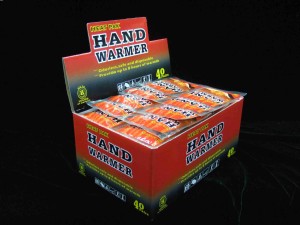For winter sports enthusiasts, hand warmers can mean the difference between calling it a day early and playing outside for as long as possible. In fact, anyone who braves cold temperatures might be tempted to try the little disposable pouches that emit warmth within seconds of being exposed to air.
Hand warmers date back centuries to when people in Japan would use hot stones to warm their hands,Portable hand warmers filled with hot ash were the version that followed. These days, you can buy a variety of hand warmers based on battery packs and lighter fuel, but disposable hand warmers rely entirely on chemistry.

Disposable hand warmers turn up the heat in your mittens by means of an exothermic reaction that, in essence, just creates rust. Each pouch typically contains iron powder, salt, water, an absorbent material, and activated carbon. When the pouch is removed from its outer packaging, oxygen drifts across the pouch’s permeable covering. With salt and water present, the oxygen reacts with the iron powder located inside to form iron oxide (Fe2O3) and release heat.
The absorbent material can be pulverized wood, a polymer such as polyacrylate, or a silicon-based mineral called vermiculite. It helps retain the moisture so that the reaction can occur. The activated carbon helps to evenly disperse the heat produced..
The main difference between disposable hand warmers and some reusable versions is the chemicals used to produce the heat-releasing reaction. Reusable hand warmers don’t contain iron but instead use a supersaturated solution of sodium acetate that releases heat as it crystallizes. Boiling the used packet restores the solution to its supersaturated state. Air-activated hand warmers can’t be reused.
Disposal hand warmers don’t just keep humans from getting too cold. Comfort Brand warmers also sell heavy-duty warmers that can help tropical fish survive transportation through chilly climates.
Post time: Nov-18-2022

